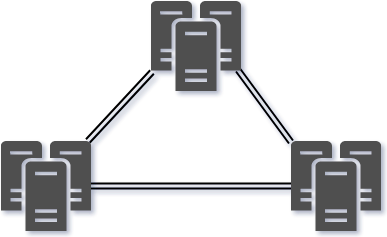Designing for Cisco Network Service Architectures (ARCH) Foundation Learning Guide: CCDP ARCH 300-320, 4th Edition:
- http://www.ciscopress.com/store/designing-for-cisco-network-service-architectures-arch-9780134426013
CCDP 300-320 videos courses:
- CBT Nuggets: https://www.cbtnuggets.com/it-training/cisco-ccdp-642-874-arch
- It says 642-874 in the URL, but it’s updated for 300-320 ARCH 3.0.
- How to Network: https://www.howtonetwork.org/design/ccdp/
- I was looking for an alternative source since INE.com doesn’t cover ARCH 3.0
- https://ine.com/products/642-873-arch-exam-course
- This isn’t the ARCH 3.0 version.
- Cisco Learning Network: https://learningnetworkstore.cisco.com/ccdp/
Cisco Design Webinars:
- Practical Network Design Fundamentals – CCDP Webinars: https://learningnetwork.cisco.com/community/learning_center/practical-network-design-fundamentals
Cisco Arch Study Material:
- https://learningnetwork.cisco.com/community/certifications/ccdp/arch/study-material
- ARCH Exam topics: https://learningnetwork.cisco.com/community/certifications/ccdp/arch/exam-topics
Cisco Design Zone:
https://www.cisco.com/c/en/us/solutions/design-zone.html#~stickynav=3
- Campus: https://www.cisco.com/c/en/us/solutions/design-zone/networking-design-guides/campus-wired-wireless.html
- Datacenter:
- Software defined Access: https://www.cisco.com/c/dam/en/us/td/docs/solutions/CVD/Campus/CVD-Software-Defined-Access-Design-Guide-2018JAN.pdf
- QoS: https://www.cisco.com/c/en/us/td/docs/solutions/CVD/Dec2017/APIC-EM-EasyQoS-DesignGuide-Dec2017.html
- IPv6 Design Zone: https://www.cisco.com/c/en/us/solutions/enterprise/design-zone-ipv6/index.html
Books / PDF
- CCDP ARCH Quick Reference ( Kevin Wallace ): http://www.ciscopress.com/store/ccdp-arch-quick-reference-9781587054990
- Enterprise Campus 3.0 Architecture: Overview and Framework: https://www.cisco.com/c/en/us/td/docs/solutions/Enterprise/Campus/campover.pdf
- Optimal Routing Design (More in-depth and useable for CCDE): http://www.ciscopress.com/store/optimal-routing-design-9781587051876
- BGP Design & Implementation: http://www.ciscopress.com/store/bgp-design-and-implementation-9781587051098
- Top Down Network Design: http://www.ciscopress.com/store/top-down-network-design-9780133434989
- End-to-End QoS: http://www.ciscopress.com/store/end-to-end-qos-network-design-quality-of-service-for-9781587143694
- Enterprise QoS Solution Reference Network Design Guide: https://www.cisco.com/c/en/us/td/docs/solutions/Enterprise/WAN_and_MAN/QoS_SRND/QoS-SRND-Book.pdf
- Datacenter Design: https://www.cisco.com/c/dam/en/us/td/docs/solutions/CVD/Aug2014/CVD-DataCenterDesignGuide-AUG14.pdf
- Routing TCP/IP Volume 1 and 2: (Not so much design but great in-depth configuration books and a great resource on technical knowledge. Don’t let the CCIE tag scare you).
Videos:
- INE.com Introduction into IPv4 and IPv6 Multicast: https://www.youtube.com/watch?v=HEcz_gb4whQ&t=0s&list=PL3UpcvaDU_Fl-4zhNy_MxdQz8j8ySWCsu&index=1
- Solarwinds Cisco QoS: Design and Best Practices for Enterprise Networks: https://www.youtube.com/watch?v=xePZcobaJUY
- “Cisco Catalyst 3560 and 3750 QoS Simplified… Seriously!” By Kevin Wallace: https://www.youtube.com/watch?v=6UJZBeK_JCs
Cisco Guides:
- OSPF: https://www.cisco.com/c/en/us/support/docs/ip/open-shortest-path-first-ospf/7039-1.html
- Datacenter:
- Campus 3.0 Virtual Switching System Design Guide: https://www.cisco.com/c/en/us/td/docs/solutions/Enterprise/Campus/VSS30dg/campusVSS_DG/VSS-dg_ch1.html
- Cisco Application Policy Infrastructure Controller Data Center Policy Model: https://www.cisco.com/c/en/us/solutions/collateral/data-center-virtualization/application-centric-infrastructure/white-paper-c11-731310.html
- Top-of-Rack / End-of-Row: https://www.cisco.com/c/en/us/products/collateral/switches/nexus-5000-series-switches/white_paper_c11-522337.html
- vPC Best Practices: https://www.cisco.com/c/dam/en/us/td/docs/switches/datacenter/sw/design/vpc_design/vpc_best_practices_design_guide.pdf
- OTV Best Practices: https://www.cisco.com/c/dam/en/us/products/collateral/switches/nexus-7000-series-switches/guide_c07-728315.pdf
- Traditional WAN Design Summary: https://www.cisco.com/c/dam/en/us/td/docs/solutions/CVD/Mar2017/CVD-WANDesign-MAR2017.pdf
- Cisco TrustSec
- QoS
- IPSec Direct Encapsulation VPN Design Guide
Various Resources:
- Discord Cisco Study Group
- https://learningnetwork.cisco.com/thread/124036
- https://www.reddit.com/r/ccdp
- https://learningnetwork.cisco.com/groups/ccdp-study-group
- http://blog.ine.com/2010/11/19/ccdp-recommended-reading-list/
Cisco Live:
- Enterprise Campus Design: Multilayer Architectures and Design Principles – BRKCRS-2031
- WAN Architectures and Design Principles – BRKRST-2041
- Campus Wired LAN Deployment Using Cisco Validated Designs – BRKCRS-1500
- Campus QoS Design-Simplified – BRKCRS-2501
- OSPF Deployment in Modern Networks – BRKRST-2337
- EIGRP Deployment in Modern Networks – BRKRST-2336
- Advanced – Scaling BGP – BRKRST-3321
- Nexus Multicast Design Best Practices – BRKIPM-3062
- Cisco FabricPath Technology and Design – BRKDCT-2081
- Advanced Enterprise Campus Design: Converged Access – BRKCRS-2888
- Cisco Unified Contact Center Enterprise Planning and Design – BRKCCT-2007








